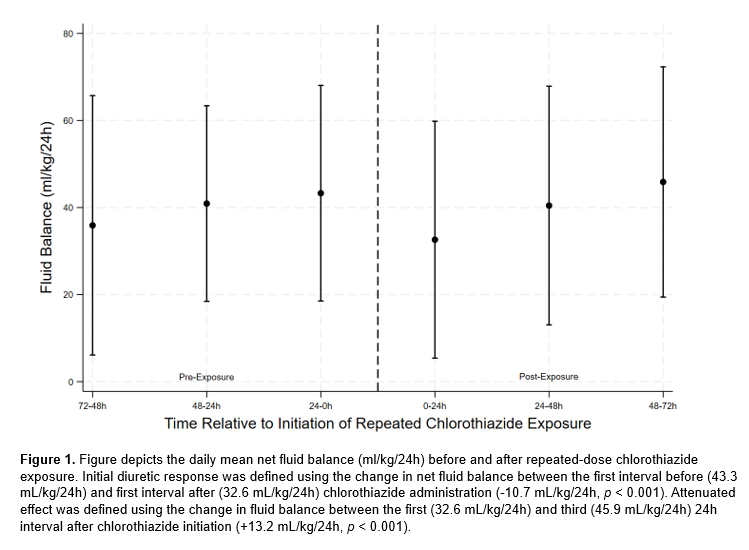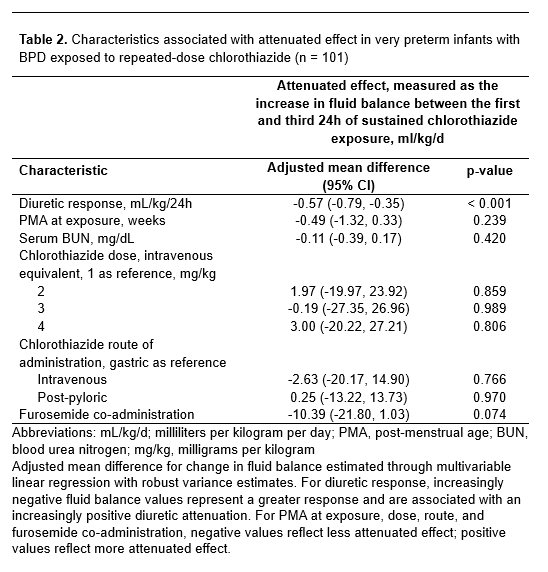Neonatal Nephrology/AKI 2
Session: Neonatal Nephrology/AKI 2
017 - Change in net fluid balance with repeated-dose chlorothiazide in hospitalized infants with bronchopulmonary dysplasia (BPD)
Saturday, April 26, 2025
2:30pm - 4:45pm HST
Publication Number: 17.4092
Timothy Nelin, Childrens Hospital of Philadelphia, Philadelphia, PA, United States; Matthew Huber, Childrens Hospital of Philadelphia, Philadelphia, PA, United States; Heidi Morris, Children’s Hospital of Philadelphia, Philadelphia, PA, United States; Erik A. Jensen, Lucile Packard Children's Hospital Stanford, San Francisco, CA, United States; Sara B.. DeMauro, Perelman School of Medicine at the University of Pennsylvania, Philadelphia, PA, United States; Nicolas P. Goldstein Novick, Children's Hospital of Philadelphia, Rose Valley, PA, United States; Joe Amoah, Childrens Hospital of Philadelphia, Philadelphia, OR, United States; Kathleen Gibbs, University of Pennsylvania/Children's Hospital of Philadelphia, Philadelphia, PA, United States; Scott A. Lorch, The Children's Hospital of Philadelphia, Philadelphia, PA, United States; Nicolas Bamat, Childrens Hospital of Philadelphia, Swarthmore, PA, United States

Timothy Nelin, MD (he/him/his)
Attending Physician
Childrens Hospital of Philadelphia
Philadelphia, Pennsylvania, United States
Presenting Author(s)
Background: Chlorothiazide is the second most commonly prescribed diuretic in infants with BPD. Yet, the diuretic effect of this medication has not been studied in this population.
Objective: To assess change in net fluid balance during sustained chlorothiazide exposure.
Design/Methods: We performed a retrospective cohort study of hospitalized infants with BPD exposed to sustained chlorothiazide use. Eligible exposures were of a consistent dose and route and administered every 12h for ≥72h, lacked fluid bolus co-administration, were preceded by >7 days without chlorothiazide use, and occurred between 36-60 weeks’ postmenstrual age (PMA). The primary outcome was net fluid balance (total intake minus total output). Fluid balance was measured for 6 discrete timepoints: the three 24h intervals before chlorothiazide initiation and the three 24h intervals that followed. Changes in net fluid balance over time were assessed using a general linear model for repeated measures with an exchangeable covariance structure. We quantified diuretic response as the change in fluid balance immediately before and after chlorothiazide initiation and diuretic attenuation as the change in fluid balance between the first and third 24h interval after chlorothiazide initiation. To identify characteristics associated with attenuation, we used linear regression with robust variance estimates, with a priori adjustment for dose, route, and furosemide co-administration plus covariates associated with attenuation at P < 0.10 in bivariable regression.
Results: We identified 101 infants with sustained chlorothiazide exposure (Table 1). Figure 1 depicts mean fluid balance (ml/kg/24h) over time. Initial diuretic response after chlorothiazide initiation was -10.7 mL/kg (p < 0.001). Net fluid balance increased by 13.2 mL/kg between the first and third 24h interval after initiation (p < 0.001). Diuretic response, PMA at exposure, and BUN met criteria for inclusion in adjusted models for diuretic attenuation. A larger diuretic response (i.e., greater decrease in fluid balance in the first 24h after chlorothiazide) remained independently associated with diuretic attenuation in multivariable modeling (Table 2).
Conclusion(s): Net fluid balance decreased in the first 24h following chlorothiazide initiation. However, net fluid balance then increased despite sustained exposure, exceeding baseline values by the third 24h exposure interval. In adjusted models, a greater initial diuretic response was associated with more diuretic attenuation. Clinicians should consider these transient impacts of chlorothiazide on fluid balance in the context of their treatment goals.
Table 1. Cohort Characteristics (n = 101 infants)
.png)
Figure 1.
 Figure depicts the daily mean net fluid balance (ml/kg/24h) before and after repeated-dose chlorothiazide exposure. Initial diuretic response was defined using the change in net fluid balance between the first interval before (43.3 mL/kg/24h) and first interval after (32.6 mL/kg/24h) chlorothiazide administration (-10.7 mL/kg/24h, p < 0.001). Attenuated effect was defined using the change in fluid balance between the first (32.6 mL/kg/24h) and third (45.9 mL/kg/24h) 24h interval after chlorothiazide initiation (+13.2 mL/kg/24h, p < 0.001).
Figure depicts the daily mean net fluid balance (ml/kg/24h) before and after repeated-dose chlorothiazide exposure. Initial diuretic response was defined using the change in net fluid balance between the first interval before (43.3 mL/kg/24h) and first interval after (32.6 mL/kg/24h) chlorothiazide administration (-10.7 mL/kg/24h, p < 0.001). Attenuated effect was defined using the change in fluid balance between the first (32.6 mL/kg/24h) and third (45.9 mL/kg/24h) 24h interval after chlorothiazide initiation (+13.2 mL/kg/24h, p < 0.001). Table 2. Characteristics associated with attenuated effect in very preterm infants with BPD exposed to repeated-dose chlorothiazide (n = 101)

Table 1. Cohort Characteristics (n = 101 infants)
.png)
Figure 1.
 Figure depicts the daily mean net fluid balance (ml/kg/24h) before and after repeated-dose chlorothiazide exposure. Initial diuretic response was defined using the change in net fluid balance between the first interval before (43.3 mL/kg/24h) and first interval after (32.6 mL/kg/24h) chlorothiazide administration (-10.7 mL/kg/24h, p < 0.001). Attenuated effect was defined using the change in fluid balance between the first (32.6 mL/kg/24h) and third (45.9 mL/kg/24h) 24h interval after chlorothiazide initiation (+13.2 mL/kg/24h, p < 0.001).
Figure depicts the daily mean net fluid balance (ml/kg/24h) before and after repeated-dose chlorothiazide exposure. Initial diuretic response was defined using the change in net fluid balance between the first interval before (43.3 mL/kg/24h) and first interval after (32.6 mL/kg/24h) chlorothiazide administration (-10.7 mL/kg/24h, p < 0.001). Attenuated effect was defined using the change in fluid balance between the first (32.6 mL/kg/24h) and third (45.9 mL/kg/24h) 24h interval after chlorothiazide initiation (+13.2 mL/kg/24h, p < 0.001). Table 2. Characteristics associated with attenuated effect in very preterm infants with BPD exposed to repeated-dose chlorothiazide (n = 101)


